We may not have the course you’re looking for. If you enquire or give us a call on +46 850282424 and speak to our training experts, we may still be able to help with your training requirements.
Training Outcomes Within Your Budget!
We ensure quality, budget-alignment, and timely delivery by our expert instructors.
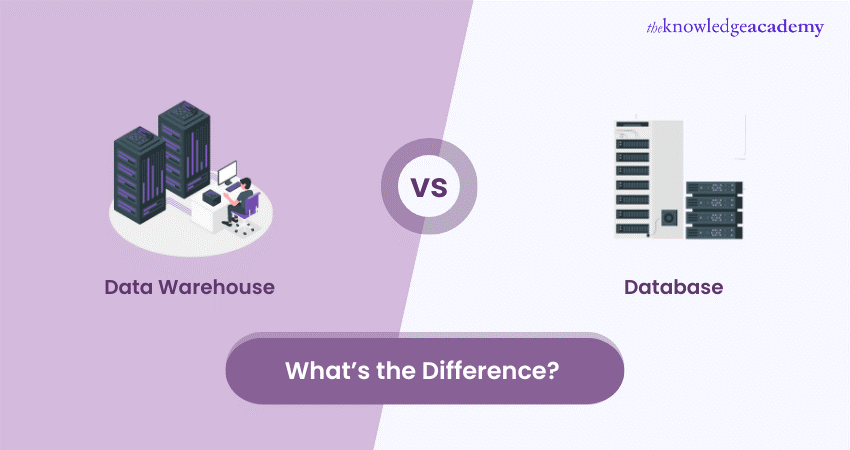
Understanding the Difference Between Data Warehouse vs Database is crucial for businesses aiming to leverage their data effectively. Both are integral in handling and organising information, yet they serve distinct purposes. This comprehensive exploration of Database and Data Warehouse will explore the definitions, characteristics, advantages, and the Difference Between Database and Data Warehouse.
Table of Contents
1) What is a Data Warehouse?
a) Characteristics of a Data Warehouses
b) Advantages of employing a Data Warehouse
c) Examples of Data Warehouses
2) What is a Database?
a) Characteristics of Databases
b) Reasons for utilising Databases
c) Instances of Databases
3) Difference between Database and Data Warehouse
a) Processing methods
b) Enhancing performance
c) Structuring data
d) Analysing data
e) Data timeline
f) Simultaneous users
g) ACID compliance in Databases
h) Commitments on service levels
i) Data type
j) Schema adaptability
4) Conclusion
What is a Data Warehouse?
A Data Warehouse is a specialised repository that centrally stores and manages vast amounts of structured and unstructured data from diverse sources within an organisation. It serves as a dedicated platform for analytical processing, distinguishing it from traditional Databases optimised for transactional tasks. The primary purpose of a Data Warehouse is to facilitate in-depth analysis and reporting, enabling businesses to gain insights into operations and create informed strategic decisions.
Characteristics of a Data Warehouse
Let’s delve into some of the characteristics of a Data Warehouse:
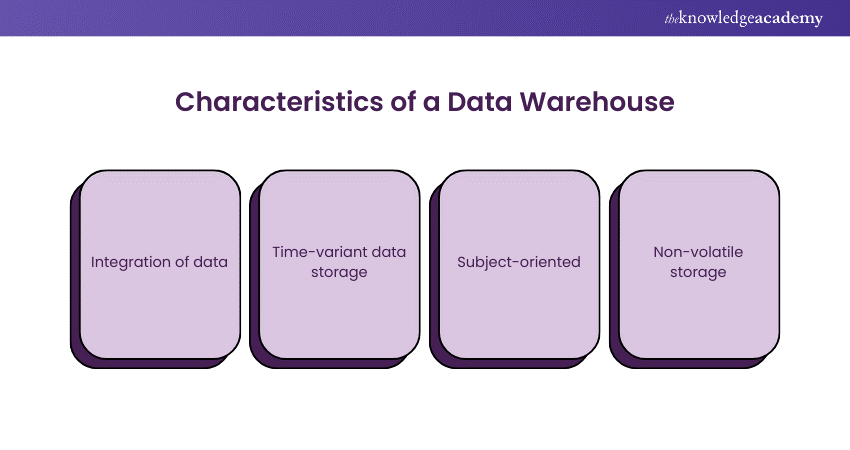
1) Integration of data:
Data Warehouses are comprehensive repositories that seamlessly integrate data from disparate sources like transactional Databases, log files, and external data feeds. This integration ensures that data, which may originate from various departments or systems within an organisation, is centralised into a unified storage solution.
2) Time-variant data storage:
The time-variant nature of data warehousing is a critical characteristic that sets it apart. Data Warehouses allow users to trace and analyse trends, patterns and changes over time by storing historical data. This historical perspective is invaluable for businesses engaged in business intelligence, strategic planning, and decision-making.
3) Subject-oriented:
Unlike generic Databases, Data Warehouses are organised around specific subjects or business areas. This subject-oriented structure tailors the data organisation to the needs of business domains, making it easier for analysts and decision-makers to focus on and extract relevant information.
4) Non-volatile storage:
The concept of non-volatile storage in Data Warehouses ensures that once data is loaded into the repository, it remains unchanged over time. This stability is crucial for creating a consistent and reliable foundation for analysis. It allows users to confidently refer to historical data, knowing that the information has not been altered since its initial inclusion.
Advantages of employing a Data Warehouse
Now, we can explore the advantages of using a Data Warehouse for businesses:

1) Enhanced decision-making: By providing a consolidated and historical view of data, Data Warehouses empower organisations to make well-informed decisions based on comprehensive analysis.
2) Improved query performance: Data Warehouses are optimised for complex queries and analytical processing, resulting in faster performance than traditional Databases.
3) Data quality and consistency: The integration process in Data Warehouses often involves cleaning and transforming data, ensuring high quality and consistency across the entire dataset.
4) Support for Business Intelligence (BI): Data Warehouses are a foundation for business intelligence tools, enabling users to create reports, dashboards, and visualisations that aid in strategic planning.
Examples of Data Warehouse
Prominent examples of Data Warehouses include:
1) Amazon Redshift: Amazon's cloud-based Data Warehouse solution designed for high-performance analysis.
2) Snowflake: A cloud-native data warehousing platform that allows seamless and scalable data processing.
3) Google BigQuery: Google Cloud's fully managed Data Warehouse for real-time analytics.
Learn more about Data Analytics and Big Data with our Data Warehouse Training – Sign up today!
What is a Database?
A Database is a structured and organised data collection stored electronically in a computer system. It serves as a repository for information, allowing users to efficiently store, retrieve, and manage data for various applications. Databases are designed to maintain data integrity using predefined schemas, ensuring consistency and preventing errors. They support transactional processing, handling tasks such as data insertion, deletion, and real-time modification.
Stay at the forefront of Big Data with our Big Data Analysis Course – Join today!
Characteristics of a Database
Let's look at some of the characteristics of a Database
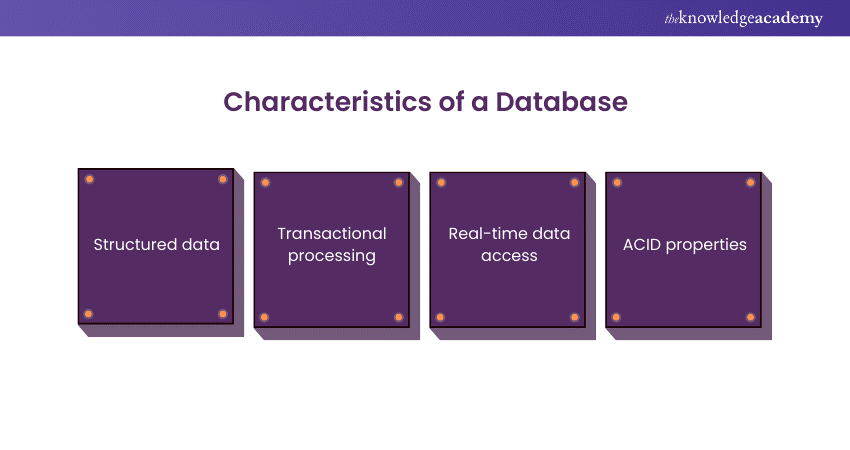
1) Structured data:
Databases meticulously organise information into tables with predefined schemas, enforcing a structured framework that ensures data integrity and consistency. This systematic arrangement facilitates efficient data retrieval and maintenance, establishing a foundation for reliable and organised data storage.
2) Transactional processing:
Databases shine in scenarios demanding swift and frequent data updates. Optimised for transactional processing, they excel in managing operations such as additions, deletions, and modifications, guaranteeing the accuracy and completeness of each transaction within the system.
3) Real-time data access:
Offering dynamic access to data in real-time, Databases are pivotal for applications requiring instant retrieval and modification of information. This responsiveness supports systems that demand timely updates, ensuring users access the most current and relevant data for their operations.
4) ACID properties:
Upholding the fundamental principles of ACID (Atomicity, Consistency, Isolation, Durability), Databases secure the reliability of transactions. This commitment ensures that each transaction is treated as a single, indivisible unit, maintaining data consistency and safeguarding against potential errors or system failures.
Reasons for utilising Databases
Let’s delve into the various reasons for using the Database:
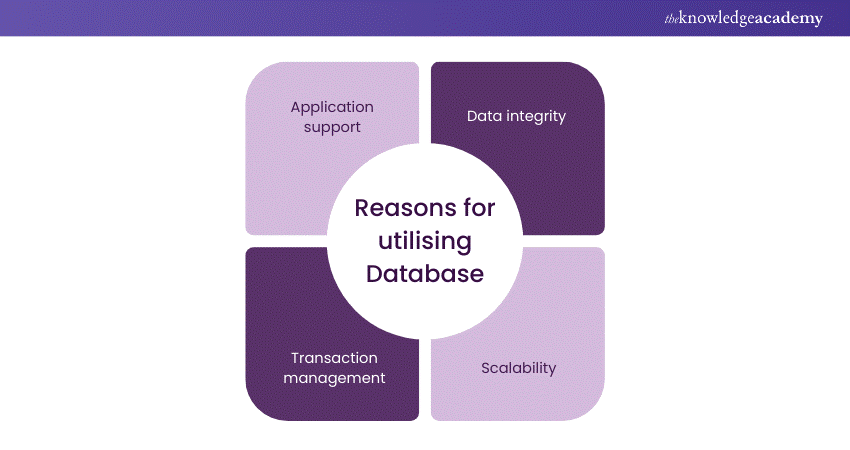
1) Application support: Databases are the backbone of many applications, ranging from Customer Relationship Management (CRM) systems to e-commerce platforms.
2) Data integrity: The structured nature of Databases ensures data integrity, removing inconsistencies and errors in the stored information.
3) Transaction management: Databases excel in managing transactions, ensuring that operations are completed successfully or leave the system in a consistent state.
4) Scalability: Databases can scale vertically or horizontally to accommodate increasing data volumes and user loads.
Instances of Database
Well-known examples of Databases include:
1) MySQL: This refers to an open-source relational Database management system (RDBMS) used mainly in web applications.
2) Oracle Database: A robust and scalable relational Database management system catering to enterprise-level applications.
3) Microsoft SQL Server: A comprehensive Database management system developed by Microsoft.
Explore the realm of Data Analytics with our Advanced Data Analytics Certification Course – Join today!
Difference between Database and Data Warehouse
Now, let's delve into the critical distinctions between a Database and a Data Warehouse, exploring various aspects that set them apart.
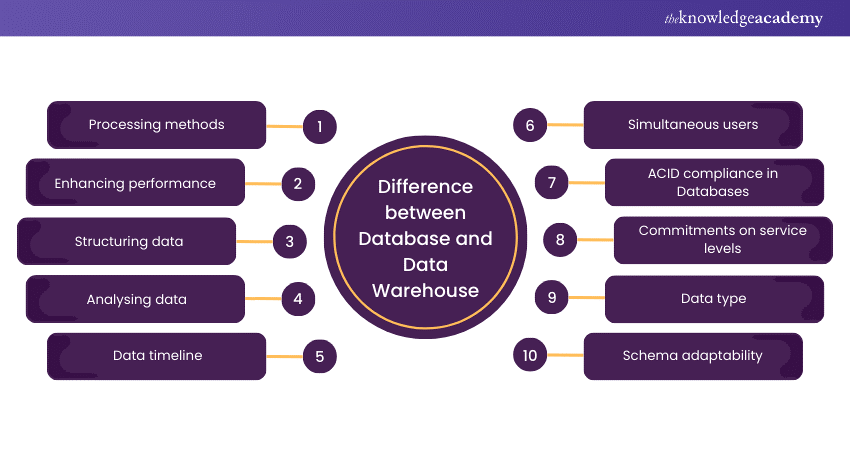
1) Processing methods
Data Warehouse: Primarily designed for analytical processing, Data Warehouses handle complex queries and aggregate large volumes of data for strategic analysis.
Database: Focused on transactional processing, Databases are optimised for rapid and frequent data retrieval and modification, supporting day-to-day operations.
2) Enhancing performance
Data Warehouse: Optimised for query performance and analytical processing, Data Warehouses utilise indexing, partitioning, and other techniques to enhance performance for complex queries.
Database: Emphasises real-time data access and transactional processing, employing techniques like caching and efficient indexing to optimise query performance.
3) Structuring data
Data Warehouse: Organised around specific business subjects, Data Warehouses structure data for analytical purposes, facilitating comprehensive analysis.
Database: Structured in tables with predefined schemas, Databases prioritise data integrity and consistency for transactional processing.
4) Analysing data
Data Warehouse: Geared towards historical and trend analysis, Data Warehouses support business intelligence tools and reporting for strategic decision-making.
Database: Designed for real-time data access and manipulation, Databases cater to applications requiring instant retrieval and modification of information.
5) Data timeline
Data Warehouse: Stores historical data, allowing for analysing trends and changes over time. Time-variant data storage is a distinctive feature.
Database: Focuses on current and transactional data, emphasising real-time access and updates.
6) Simultaneous users
Data Warehouse: Typically supports a smaller number of simultaneous users engaged in analytical processing and decision support.
Database: Designed to handle many simultaneous users involved in day-to-day transactional operations.
7) ACID compliance in Databases
Data Warehouse: While Data Warehouses ensure data consistency, they may not strictly adhere to the ACID properties, as their primary focus is analytical processing.
Database: Adheres to ACID properties to guarantee the reliability of transactions in transactional processing.
8) Commitments on service levels
Data Warehouse: Often prioritises performance and response times, with service level commitments tailored to analytical workloads.
Database: Focuses on transactional consistency and reliability, with service-level commitments addressing the demands of real-time operations.
9) Data type
Data Warehouse: Handles various data types, including structured, semi-structured, and unstructured data, to support comprehensive analysis.
Database: Primarily deals with structured data, ensuring data consistency through predefined schemas.
10) Schema adaptability
Data Warehouse: Offers flexibility in schema design, allowing for adaptations to changing analytical needs and evolving business requirements.
Database: Relies on a fixed schema, requiring careful planning and consideration during initial design.
11) Advantages
Data Warehouse:
a) Supports strategic decision-making through comprehensive analysis.
b) Provides a centralised and optimised environment for analytical processing.
c) Enhances query performance for complex analytical queries.
Database:
a) Sustains real-time data access and manipulation.
b) Ensures data integrity and consistency for transactional processing.
c) Scales efficiently to handle increasing data volumes and user loads.
12) Disadvantages
Data Warehouse:
a) Requires significant upfront investment in infrastructure and design.
b) It may need to be better suited for real-time transactional processing.
Database:
a) Analytical processing may be less efficient for complex queries.
b) Historical data analysis may be limited.
Learn more about Hadoop with our Hadoop Administration Training – Join today!
Conclusion
Understanding the Difference Between Database and Data Warehouse is pivotal for organisations seeking to leverage the full potential of their data. The choice between a Data Warehouse vs Database depends on the potential needs and goals of the organisation. As technology advances, the line between these two entities may blur, emphasising the importance of staying informed and adaptable in the dynamic realm of data management.
Explore the realm of data analytics with our Data Analytics with R Course – Join today!
Frequently Asked Questions

No, Data Warehousing is not dead. It continues to evolve, adapting to modern needs. With the rising importance of analytics, data warehousing remains a crucial asset for organisations, providing a structured platform for strategic data analysis and decision-making.

No, big data won't replace Data Warehouses. While big data technologies handle vast and diverse datasets, Data Warehouses excel in structured analytics. They complement each other, with Data Warehouses offering organised and optimised environments for specific analytical tasks.

The Knowledge Academy takes global learning to new heights, offering over 30,000 online courses across 490+ locations in 220 countries. This expansive reach ensures accessibility and convenience for learners worldwide.
Alongside our diverse Online Course Catalogue, encompassing 17 major categories, we go the extra mile by providing a plethora of free educational Online Resources like News updates, Blogs, videos, webinars, and interview questions. Tailoring learning experiences further, professionals can maximise value with customisable Course Bundles of TKA.

The Knowledge Academy’s Knowledge Pass, a prepaid voucher, adds another layer of flexibility, allowing course bookings over a 12-month period. Join us on a journey where education knows no bounds.

The Knowledge Academy offers various Big Data and Analytics including Big Data Analysis, Data Warehousing Training, etc. These courses cater to different skill levels, providing comprehensive insights into Big Data Training.
Our Data Analytics and AI blogs cover a range of topics related to cloud computing courses, offering valuable resources, best practices, and Data Analysis insights. Whether you are a beginner or looking to advance your Big Data skills, The Knowledge Academy's diverse courses and informative blogs have you covered.
Upcoming Data, Analytics & AI Resources Batches & Dates
Date
 Data Warehousing Training
Data Warehousing Training
Fri 7th Feb 2025
Fri 4th Apr 2025
Fri 6th Jun 2025
Fri 8th Aug 2025
Fri 3rd Oct 2025
Fri 5th Dec 2025







 Top Rated Course
Top Rated Course



 If you wish to make any changes to your course, please
If you wish to make any changes to your course, please


